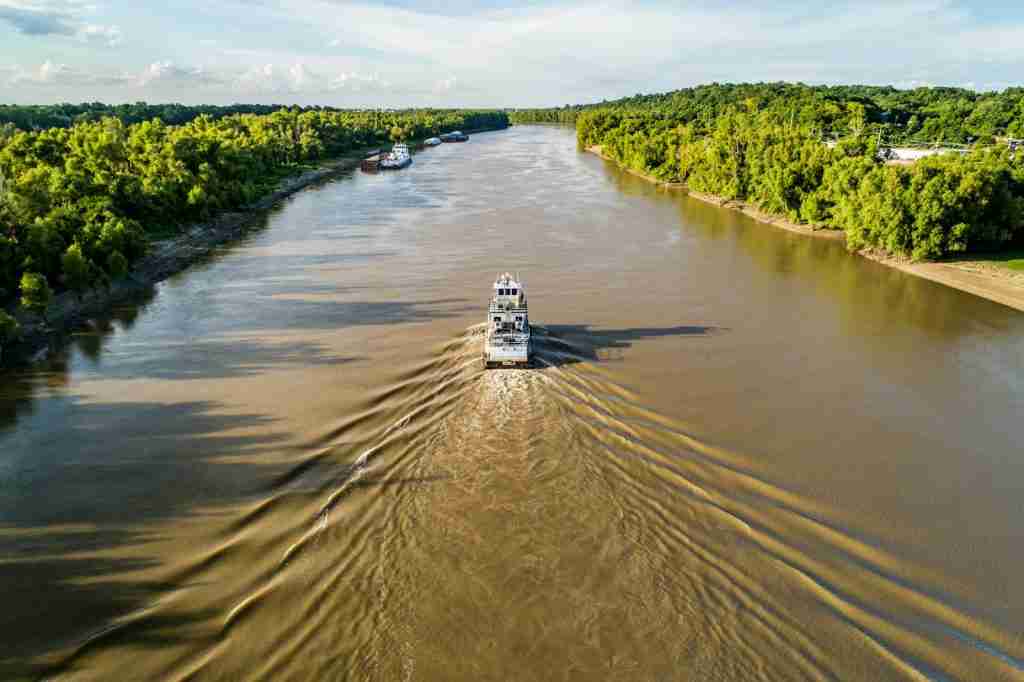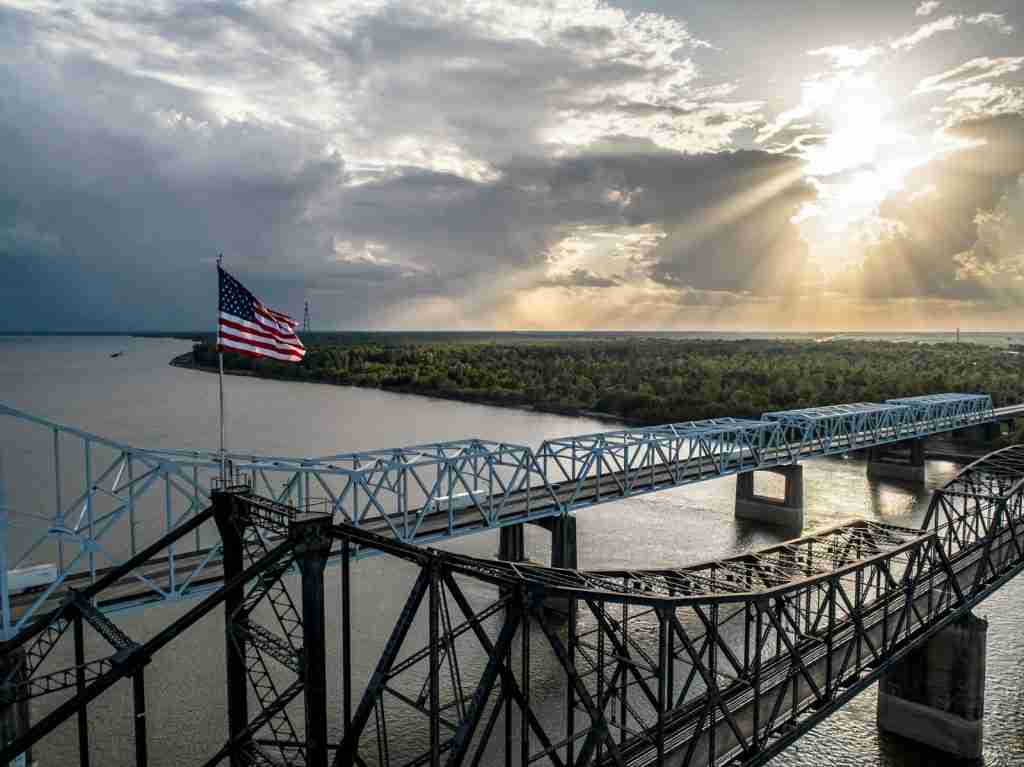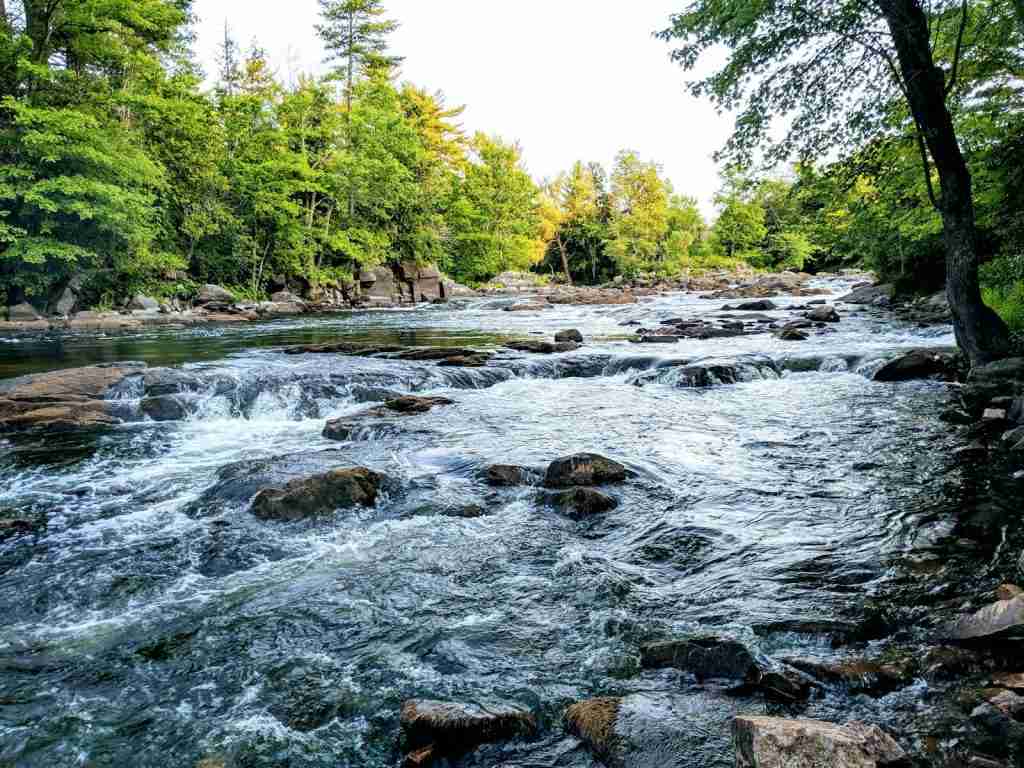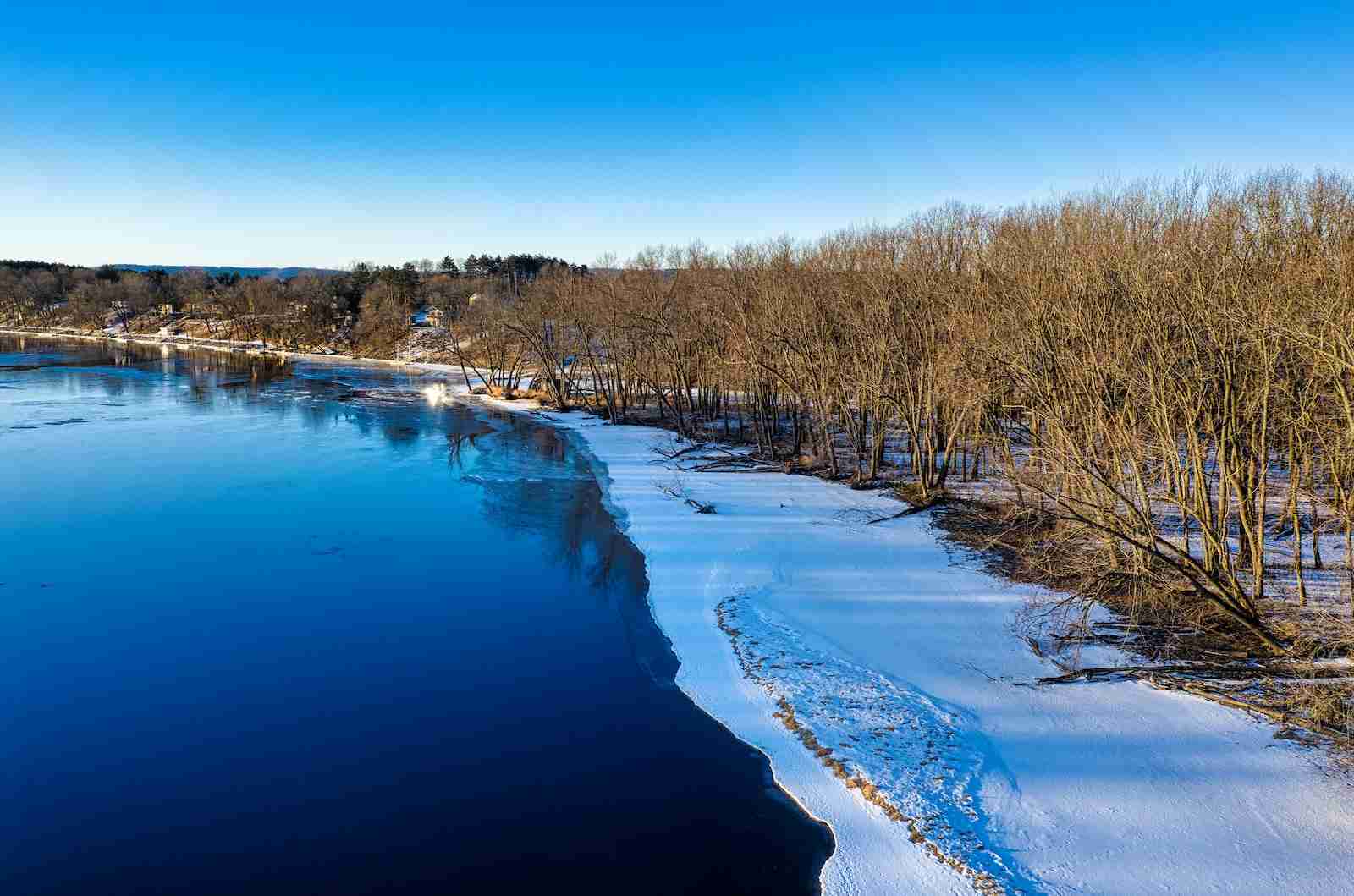25 Facts About The Mississippi River You Didn’t Know
1. The Mississippi River drains about 40% of the U.S., covering 1.2 million square miles.
The Mississippi River, a monumental force in the United States, drains around 40% of the country, encompassing an area of 1.2 million square miles. This drainage basin, spanning from Minnesota’s northern forests to the warm waters of the Gulf of Mexico, covers a vast array of ecosystems and climates.
The river itself stretches approximately 3,730 kilometers (2,320 miles), serving as a lifeline that supports diverse wildlife, facilitates agriculture, and provides water resources for millions.
2. Hernando De Soto was the first European to see the Mississippi River.
On May 8, 1541, the Spanish explorer Hernando De Soto became the first European to sight the Mississippi River. He arrived near present-day Natchez, riding a white horse and wearing Renaissance clothing.
This event was a crucial point in history, recording the initial European encounter with one of North America’s biggest rivers.
3. Over 18 million people from more than 50 cities depend on the river for their daily water supply.
The Mississippi River is a vital source of water for more than 50 cities, including major urban centers such as Minneapolis, St. Louis, and New Orleans.
It serves as a lifeline for over 18 million people who depend on its waters for their daily needs. This enormous reliance highlights the river’s critical role in supporting communities across its vast expanse.
4. The river drops 1,475 feet from its source to the Gulf of Mexico.

The Mississippi River starts high up and goes down 1,475 feet until it meets the Gulf of Mexico. This means the river flows downhill a lot from where it starts to where it ends.
As it moves, it passes through many places, helps plants and animals, and brings water to towns and cities. This drop helps the river keep moving and doing its important work.
5. The Mississippi River and its tributaries drain at least 30 U.S. states and 2 Canadian provinces.
The Mississippi River, along with its tributaries, drains a vast expanse covering over 30 U.S. states, including crucial regions like Minnesota, Illinois, and Louisiana. Beyond the U.S. borders, the river extends its influence to two Canadian provinces, Manitoba and Ontario.
This extensive drainage network highlights the river’s significance in shaping the water resources and ecosystems of diverse and influential North American regions.
6. There are over 170 bridges crossing the Mississippi River.
Over 170 bridges span the Mississippi River, fostering connections and easing travel across its vast waters. Some notable structures include the Gateway Arch Bridge in St. Louis, the historic Stone Arch Bridge in Minneapolis, and the Crescent City Connection in New Orleans.
These bridges form a crucial network, enhancing transportation and accessibility and contributing significantly to the economic and social connectivity of the regions along the Mississippi.
7. The river is part of the world’s 4th largest drainage basin.
The Mississippi River is integral to the world’s fourth-largest drainage basin, with a significant impact on the surrounding ecosystems. Noteworthy basins include the Amazon River Basin, which is the largest, and the Congo River Basin, which ranks second.
This expansive drainage network emphasizes the Mississippi’s global importance, influencing environmental dynamics and contributing to the intricate balance of water systems across the continents.
8. The first bridge over the Mississippi was built in 1855.

The Father Louis Hennepin Bridge was constructed in 1855 as the first bridge over the Mississippi River above St. Anthony Falls, taking advantage of the river’s transportation opportunities.
This historic bridge improved connectivity and transportation across the Mississippi, leaving a lasting impact on the region’s transportation landscape.
9. The river played a crucial role in the Civil War victory over the Confederacy.
The river’s strategic importance was pivotal in securing the Union’s victory over the Confederacy during the Civil War. Serving as a crucial transportation route, it facilitated the movement of troops and supplies, providing a significant advantage to the Union forces.
This strategic use of the river played a decisive role in shaping the outcome of key battles and contributed to the overall success of the Union in the conflict against the Confederacy.
10. The river is home to over 260 fish species, making up 25% of all fish species in North America.
The Mississippi River is home to over 260 fish species, including some that are endangered, like the pallid sturgeon. It constitutes 25% of all North American fish species, such as largemouth bass, bluegill, catfish, and crappie.
Fishing enthusiasts with a valid license from either Kansas or Missouri can explore and cast their lines in the river’s flowing sections, backwaters, and connected oxbow lakes.
11. It supports 50 mammal species, 145 amphibian species, and 325 bird species.
The Mississippi River sustains a thriving ecosystem, hosting an impressive array of wildlife. Among its inhabitants are numerous mammal species, including white-tailed deer and raccoons, creating a diverse terrestrial community.
The river is home to a variety of amphibians, such as bullfrogs and salamanders, contributing to its rich aquatic biodiversity.
Furthermore, the skies above are adorned with numerous bird species, including majestic bald eagles and graceful great blue herons, highlighting the river’s significance as a habitat for a wide range of creatures.
12. A Slovenian swimmer named Martin Strel swam the entire length of the Mississippi River in 68 days.
Slovenian swimmer Martin Strel achieved a remarkable feat by swimming the entire length of the Mississippi River in 68 days from July 4 to September 9, 2002. His historic endeavor, named Eye to Eye, began in northern Minnesota and concluded at the Gulf of Mexico in Louisiana, earning him a Guinness World Record certificate.
In a later tribute, former Navy SEAL Chris Ring replicated this feat from June 6 to December 4, 2015, swimming for 181 days in honor of fallen American servicemen and servicewomen.
13. The name Mississippi means Father of Waters.
The term “Mississippi” finds its roots in the Anishinaabe (Ojibwe or Algonquin) name “Misi-ziibi,” meaning Great River. The river served as a crucial border for the United States in the 18th century, defined by the Treaty of Paris and later influenced by the Louisiana Purchase.
This geographical significance is reflected in landmarks like the Gateway Arch in St. Louis, symbolizing the opening of the West.
The river continues to shape regional distinctions, evident in classifications such as the highest peak east of the Mississippi and influences on broadcast call signs.
14. It ranks as the 4th longest river in the world and the second-longest in the U.S.
Flowing through the heart of the United States, the Mississippi River holds the distinction of being the second-longest river in the country.
Globally, it ranks as the fourth-longest, with only the Nile surpassing it in length. In the U.S., it yields precedence only to the mighty Missouri River, while internationally, the Amazon River and the Nile claim the top spots in length.
15. The Great Flood of 1927 was a historic flooding event that led to significant social and political changes in the U.S.
In 1927, the United States witnessed the Great Flood, a catastrophic event that overwhelmed the Mississippi River’s banks, causing widespread destruction. This disaster not only submerged homes and farmland under water, displacing hundreds of thousands of people, but also sparked a shift in the political landscape.
The flood’s aftermath saw many African Americans, who were disproportionately affected, move from the Republican Party (historically the party of Lincoln and abolition) to the Democratic Party, driven by promises of better support and recovery aid.
16. The river is divided into four levels or sections, with different characteristics in each.

The Mississippi River unfolds in four distinct sections, each with unique traits. It begins as a narrow stream in Minnesota, evolving into a wide channel supporting commerce and merging with major tributaries like the Missouri and Ohio rivers, enhancing its ecological diversity.
Finally, it spreads into a rich delta in the Gulf of Mexico, nurturing diverse habitats. This segmentation illustrates the river’s multifaceted role across its journey.
17. Its widest point, Lake Winnibigoshish, stretches over 11 miles across.
At its broadest stretch, the Mississippi River embraces Lake Winnibigoshish, a vast expanse of water that spans more than 11 miles in width. This remarkable width is found in northern Minnesota, where the river’s journey weaves through landscapes of dense forests and rich biodiversity.
Lake Winnibigoshish, often referred to as Lake Winnie, serves as a pivotal point in the river’s path, offering a habitat for a plethora of wildlife and a popular destination for fishing and recreation.
18. Water-skiing was invented on the Mississippi River by Ralph Samuelson.
Ralph Samuelson, at the young age of 18, revolutionized leisure sports by inventing water-skiing on Lake Pepin, part of the Mississippi River, in 1922. His innovation stemmed from a desire to mimic snow skiing on water, evolving from initial experiments with barrel staves to the creation of the first water skis.
Samuelson’s breakthrough came after numerous attempts, finally achieving success by leaning back and pointing the ski tips upwards, a technique still used by water skiers today.
19. It takes approximately three months for water to travel from the river’s headwaters at Lake Itasca to the Gulf of Mexico.
Water starts at Lake Itasca in Minnesota and takes about three months to reach the Gulf of Mexico. This path stretches over 2,320 miles, crossing different areas and helping many plants and animals.
The water’s slow movement shows how big and important the Mississippi River is, connecting places and nature along its way.
20. It discharges 16,792 cubic meters of water per second into the Gulf of Mexico.

The Mississippi River, with its impressive flow, sends 16,792 cubic meters of water every second into the Gulf of Mexico. This immense volume ranks it as the 15th largest river globally in terms of discharge. Such a figure underscores the river’s vast scale and its critical role in shaping the ecological and geographical landscape of the North American continent.
By channeling water from its expansive basin, which includes parts of 32 states and two Canadian provinces, the Mississippi supports a wide array of life and human activity along its course, making it a cornerstone of the region’s environmental and economic health.
21. The Great Raft, a massive logjam, once blocked the Mississippi for centuries until it was cleared in the 19th century.
The Great Raft was a massive collection of logs that blocked the Red and Atchafalaya rivers for centuries, starting as early as the 12th century until it was cleared in the 1830s. It was over 160 miles long at its largest point and had a significant impact on the ecosystem and the way of life of the Caddo tribe.
Who valued it for its protective qualities and its contribution to making their farmland fertile. The removal of the Great Raft, led by Henry Miller Shreve with the help of steam-powered snag boats, brought about a revolution in navigation and settlement along these rivers.
22. The deepest point of the Mississippi, near Algiers Point in New Orleans, reaches 200 feet.
The Mississippi River near Algiers Point in New Orleans is approximately 200 feet deep due to its unique geography and flow dynamics. Despite its surface being above sea level, its riverbed dips below sea level all the way to Natchez.
The deep channel is crucial in the river’s interaction with the Gulf of Mexico and can lead to saltwater intrusion, which affects freshwater supply.
23. During Hurricane Isaac in 2012, the Mississippi River flowed backward.
In 2012, the force of Hurricane Isaac was so powerful that it caused the Mississippi River to reverse its flow for a full day. Instruments located in Belle Chasse, Louisiana, captured this rare event, showing the river moving upstream at a rate of nearly 5,200 cubic meters per second, a significant deviation from its normal downstream flow.
This phenomenon, driven by the hurricane’s storm surge, elevated the river’s height by nearly 3 meters above its usual level, showcasing the immense power of nature to alter even the course of one of the world’s most significant rivers temporarily.
24. More than 500 million tonnes of cargo are transported on the Mississippi River annually.

Every year, the Mississippi River serves as a vital conduit for commerce, facilitating the transport of over 500 million tonnes of cargo. This immense volume underscores the river’s critical role in supporting the U.S. economy, enabling the efficient movement of goods ranging from agricultural produce to industrial materials.
As a backbone of the nation’s transportation infrastructure, the Mississippi River not only connects the heartland to global markets but also sustains countless jobs and communities along its banks.
25. Mississippi is one of the most commonly misspelled U.S. place names on Google.
The name Mississippi frequently finds itself among the list of U.S. place names that people often get wrong when typing into Google.
This spelling challenge reflects the unique combination of letters in the state’s name, which includes a double “s” followed by a double “p,” a sequence that is uncommon in the English language.
FAQS
The Mississippi River starts in Lake Itasca in northern Minnesota and ends at the Gulf of Mexico in Louisiana.
It is highly unlikely that the Mississippi River will completely dry up. The Mississippi River is a major waterway that is fed by a large drainage basin covering over 1.2 million square miles. It is also connected to a number of other rivers and waterways, which contribute to its flow. While the water levels of the Mississippi River can fluctuate due to various factors, such as drought, heavy rainfall, and human activities, it is not expected to dry up completely.
The Mississippi River does mix with the ocean, but the mixing is not immediately visible due to the difference in the density and salinity of the water. The Mississippi River carries a large volume of freshwater from its drainage basin, which is relatively low in salt content compared to the saltwater of the Gulf of Mexico. When the freshwater of the Mississippi River meets the saltwater of the Gulf of Mexico, it forms a layer at the surface that is less dense than the saltwater below it.
Swimming in the Mississippi River can be dangerous due to the strong currents, unpredictable weather conditions, and potential hazards such as debris and submerged objects. It is important to be cautious and avoid swimming in the Mississippi River unless you are a strong swimmer and have received proper training and supervision.
The depth of the Mississippi River varies depending on factors such as location, time of year, and water levels. On average, it is about 20 feet deep, but some areas are deeper, reaching up to 100 feet or more. The deepest part is near the Gulf of Mexico, where it reaches around 200 feet.
The deepest part of the Mississippi River is located near Algiers Point in New Orleans, Louisiana, with a depth of approximately 200 feet.
The Missouri River is longer than the Mississippi River, spanning approximately 2,540 miles compared to the Mississippi River’s 2,340 miles.







